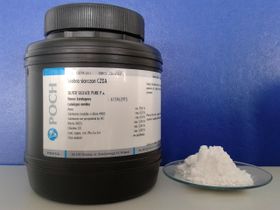Difference between revisions of "Silver sulfate"
(→Preparation) |
|||
| Line 123: | Line 123: | ||
==Preparation== | ==Preparation== | ||
Silver sulfate can be prepared by reacting concentrated sulfuric acid with [[silver nitrate]]: | Silver sulfate can be prepared by reacting concentrated sulfuric acid with [[silver nitrate]]: | ||
| + | |||
: 2 AgNO<sub>3</sub> + H<sub>2</sub>SO<sub>4</sub> → Ag<sub>2</sub>SO<sub>4</sub> + 2 HNO<sub>3</sub> | : 2 AgNO<sub>3</sub> + H<sub>2</sub>SO<sub>4</sub> → Ag<sub>2</sub>SO<sub>4</sub> + 2 HNO<sub>3</sub> | ||
| + | |||
| + | Hot sulfuric acid will dissolve silver metal, forming silver sulfate: | ||
| + | |||
| + | : 2 Ag + 2 H<sub>2</sub>SO<sub>4</sub> → Ag<sub>2</sub>SO<sub>4</sub> + SO<sub>2</sub> + 2 H<sub>2</sub>O | ||
==Projects== | ==Projects== | ||
Revision as of 15:55, 4 April 2023
 Silver(I) sulfate sample and original bottle.
| |
| Names | |
|---|---|
| IUPAC name
Silver sulfate
| |
| Other names
Disilver(1+) sulfate
Silver(I) sulfate | |
| Identifiers | |
| Jmol-3D images | Image |
| |
| Properties | |
| Ag2SO4 | |
| Molar mass | 311.799 g/mol |
| Appearance | White solid |
| Odor | Odorless |
| Density | 5.45 g/cm3 (at 20 °C) |
| Melting point | 652.2–660.0 °C (1,206.0–1,220.0 °F; 925.4–933.1 K) |
| Boiling point | 1,085 °C (1,985 °F; 1,358 K) |
| 0.57 g/100 mL (0 °C) 0.69 g/100 mL (10 °C) 0.83 g/100 mL (25 °C) 0.96 g/100 mL (40 °C) 1.33 g/100 mL (100 °C) | |
| Solubility | Soluble in conc. sulfuric acid Slightly soluble in acetates, acetone, alcohols, amides, aq. acids, diethyl ether Insoluble in ethanol |
| Vapor pressure | ~0 mmHg |
| Thermochemistry | |
| Std molar
entropy (S |
200.4 kJ/mol |
| Std enthalpy of
formation (ΔfH |
−715.9 kJ/mol |
| Hazards | |
| Safety data sheet | ScienceLab |
| Flash point | Non-flammable |
| Related compounds | |
| Related compounds
|
Silver nitrate Silver perchlorate |
| Except where otherwise noted, data are given for materials in their standard state (at 25 °C [77 °F], 100 kPa). | |
| Infobox references | |
Silver sulfate is an ionic compound of silver with the formula Ag2SO4, mainly used in silver plating and as a non-staining substitute to silver nitrate. It is also used in analytical chemistry.
Contents
Properties
Chemical
Silver sulfate darkens upon exposure to light, though this process requires many hours.
Physical
Silver sulfate is a white solid, extremely poorly soluble in water (0.83 g/100 ml at 25 °C), but soluble in concentrated sulfuric acid. It is quite stable under ordinary conditions of use and storage, though it darkens upon exposure to air or light.
Availability
Silver sulfate is sold by various chemical suppliers, though it's not cheap.
Preparation
Silver sulfate can be prepared by reacting concentrated sulfuric acid with silver nitrate:
- 2 AgNO3 + H2SO4 → Ag2SO4 + 2 HNO3
Hot sulfuric acid will dissolve silver metal, forming silver sulfate:
- 2 Ag + 2 H2SO4 → Ag2SO4 + SO2 + 2 H2O
Projects
- Silver plating
- Compound collecting
Handling
Safety
Silver sulfate should not be handled without protection, as it will darken when exposed to light.
Storage
Silver sulfate should be kept in closed bottles, away from light and air.
Disposal
Best to recycle it.
References
Relevant Sciencemadness threads
- Chemical pages without CAS Registry Number
- Articles without EBI source
- Chemical pages without ChemSpiderID
- Chemical pages without DrugBank identifier
- Articles without KEGG source
- Articles without InChI source
- Articles without UNII source
- Articles containing unverified chemical infoboxes
- Chemical compounds
- Inorganic compounds
- Silver compounds
- Sulfates